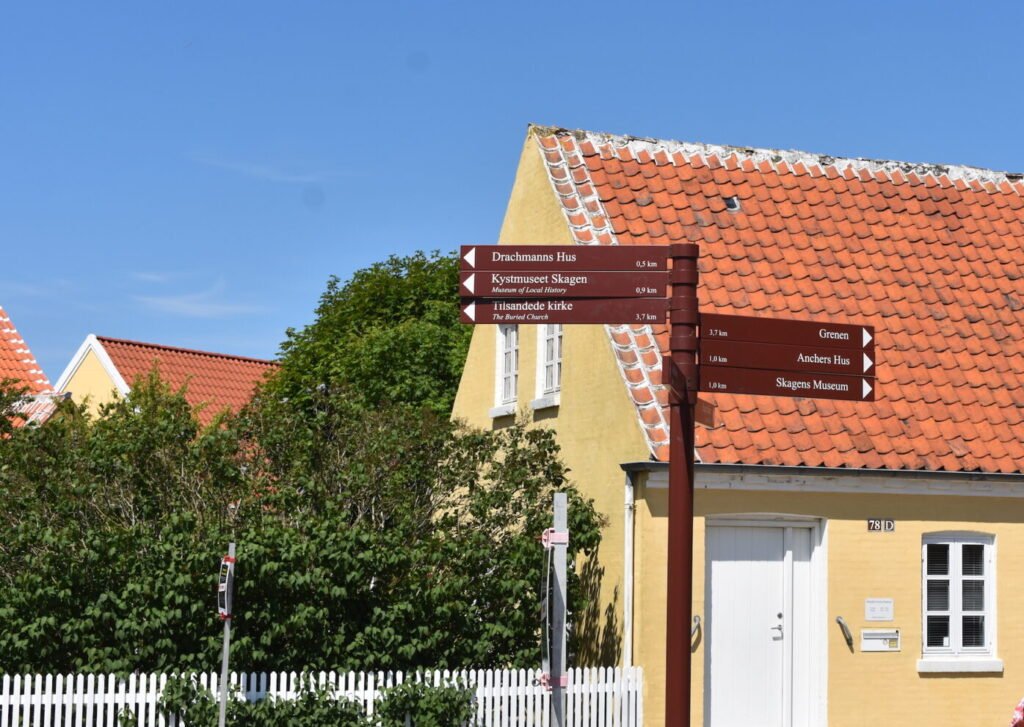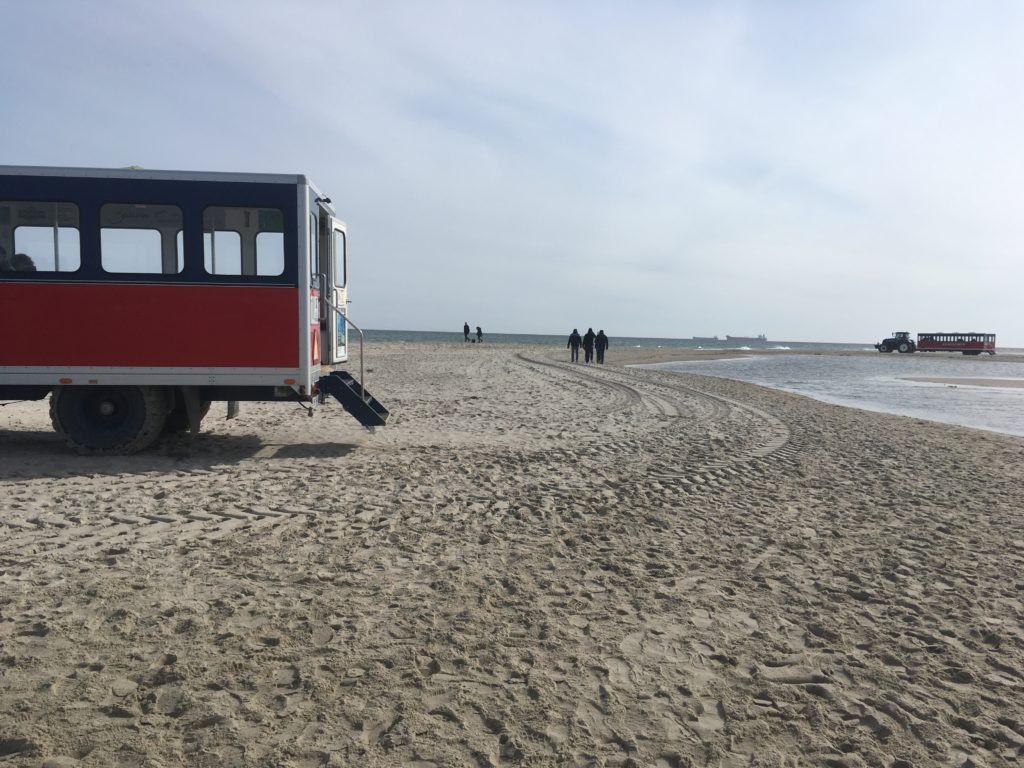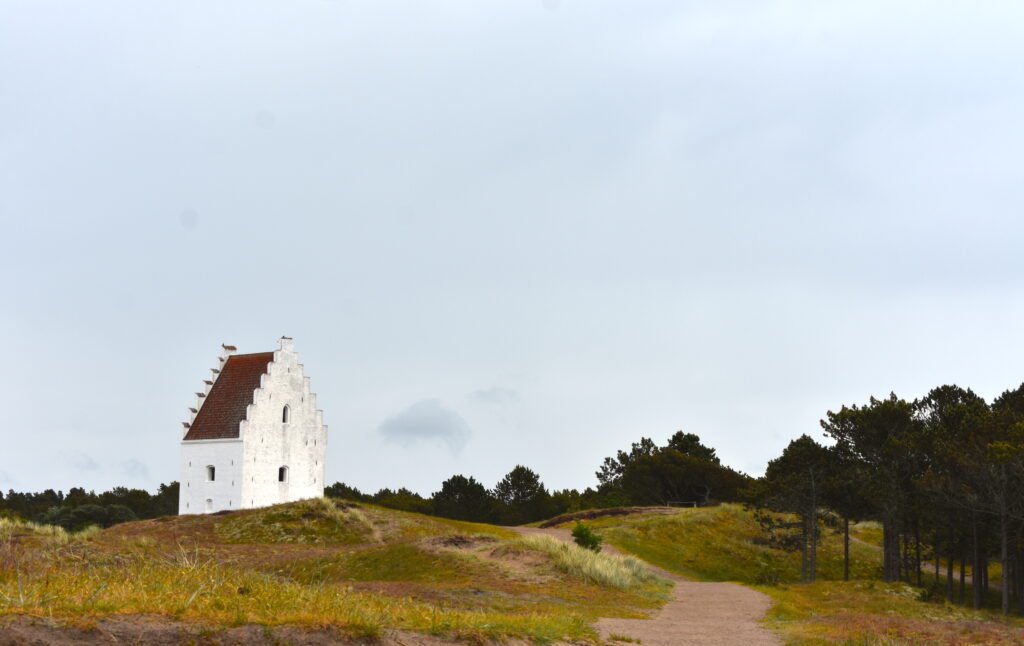
Skagen is the northernmost town in Denmark. It’s a popular travel destination during the summer but you can visit all year round. Skagen is most famous for being the preferred location of many Danish painters during the 19th century. It also has its trademark yellow houses with red roofs, great seafood restaurants, and a long beach where two seas visibly flow into each other.
This guide will give you all the information you need to know about Skagen. My family comes from this town and I’ll go through the main tourist attractions below + share suggestions for even more things to do in Skagen, including some lesser known sights and attractions. Let’s get started!
Contents
Grenen

Grenen is the peak of Skagen – a long sandy beach area and actually the northernmost point of continental Denmark.
The two seas of Skagerrak and Kattegat flow into each other at the peak, and you can watch it happen while standing on the beach!
Due to strong currents and waves, it is not allowed to bathe at this beach, but it is allowed to stand with just the feet in the water. Even though bathing is not allowed, Grenen remains a highly popular tourist spot. The reason is obviously that you can see the two seas flow into each other – but also that you can take long walks and enjoy the fresh air.
How do you get to the top of the beach to watch the two seas? Take the historic bus, Sandormen. It’s a special beach bus that will take you to the peak. By far the best option if you don’t want to walk for 30 minutes in the sand!
And a final thing about Grenen in Skagen: It is the place in Denmark where you can observe the largest variety of bird species. During spring, it is even considered the best place in all of Northern Europe to observe birds of prey, as they will be present in significant numbers.
Den Tilsandede Kirke

Four kilometers southwest of Skagen’s town center, we find one of the most famous attractions in the northern region.
Den Tilsandede Kirke (The Sand-Covered Church in English) is a very charming site. This old church was built by the end of the 14th century. However, due to the sand deflation by the coast, it started to become partly buried in the 17th century. Originally named Skt. Laurentii Kirke, people eventually had to dig their way in on Sundays, so it ultimately closed for service in 1795.
But nowadays it’s an important tourist attraction in Skagen because of its distinct look. And because of the story, of course. The National Museum of Denmark removed some of the sand blocking the church in 1909, so now you can easily see most of the church, even though the bottom part is still covered with sand. That part has been kept, to maintain at least some of the church’s signature look. H.C. Andersen described the church in his writings and so did many other authors throughout the years.
Visiting The Sand-Covered Church is free and highly recommended!
Skagen Church
Den Tilsandede Kirke is not the only church in Skagen. There is also the central church, which is much newer and still in use on Sundays. Thanks to its tower, it has the appearance of a church, but the yellow color of the outer walls and the red roof make it very reminiscent of any normal house in Skagen. This is simply the way buildings look in this town.
DON’T MISS: Where to Stay in Skagen – Hotel Recommendations
Skagen Church was built to replace the sand-covered Skt. Laurentii church. The location was also a lot better since it is closer to the locals. Talented Danish artists, such as Andreas Paulsen, have provided paintings and sculptures to the interior, so a look inside the church can be very interesting.
Museum of Skagen
Skagens Museum, known as the Museum of Skagen in English, is a popular city museum with over 130,000 annual visitors.
It is considered to be one of the best museums in Denmark. A large part of the collection focuses on Skagensmalerne – the famous painters who lived in Skagen during the late 19th and early 20th centuries. You can see the paintings of Ancher, Krøyer, Tuxen, Johansen, Drachmann and others.
The Museum of Skagen was founded in 1908 and it is located inside the former inn of the Brøndum Hotel. In beautiful settings, you can get acquainted with the artworks of Denmark’s best artists in the realist era. A must-visit museum for any art or culture aficionado who happens to be in Skagen!
It usually opens at 9 am, although some days at 10 am. It usually closes at 17. Stay updated on prices and opening hours on the official website.
Ancher’s House
Speaking about art: A visit to Ancher’s House is also highly recommended.
Arguably, the two most famous painters of the bunch in Skagen were Anna & Michael Ancher. They bought this specific house in 1884 and lived there until they died in 1927 and 1935, respectively. The house remained in the hands of the Ancher family up until 1964. We can only wonder how much great art was created in this house, and how many ideas were discussed there – and that makes it and interesting place to visit.
These days, it is used for exhibitions – so it is practically a small museum. While not as large as the Museum of Skagen, it is very charming and if you truly want to explore the history and the local art, you should absolutely visit Ancher’s House.
Opening hours and entry prices are equal to that of the regular Skagen Museum since they are run by the same organization.
Vippefyret
Near the coast, you can take a look at Vippefyret – often referred to in English as Skagen’s Lever Light.
It is a very unique construction that was built to provide a mechanical navigational light to fishermen. It was the first of its kind, and even though the original light is now gone, it is replaced by a replica at the site where the original once stood. As one of Skagen’s many free attractions, it is a good idea to stop by and see the monumental Lever Light up close.
The Grey Lighthouse
Skagen’s Grey Lighthouse is now over 150 years old, but it still remains in service.
It is a famous construction designed by Niels Sigred Nebelong, and until 1952 it was the tallest lighthouse in Denmark. Visitors can enter every day of the year, aside from the days around Christmas and New Year’s Eve. The lighthouse has also become a popular place to go for bird-watching enthusiasts.
The Bunker Museum
When you walk the beaches of Skagen, you will see several bunkers from World War II. During the German occupation, the invading soldiers built bunkers along the coasts of Denmark, and several of them were built on the beaches of Skagen.
These bunkers were originally used as places to stock supplies and treat wounded soldiers. After the war, they were left useless, but eventually, locals decided to turn some of these bunkers into museums.
One of them is the Skagen Bunker Museum. It is privately owned, and not run by the state or the municipality. It gives an introduction to the history of how the bunkers were used during WWII, and there are exhibitions showing uniforms, weapons and artifacts found from the WWII era. Skagen Bunker Museum is season-based and it’s only open between April and October. If you come to Skagen during this time, it makes sense to visit this historical attraction.
The museum is open from 11.00 to 15.00 every day with extended opening hours in the summer. Entry is 60 DKK with reduced rates for children and seniors.
As a side note, there are also empty bunkers standing on the beaches that you can go and have a look at. These are not necessarily part of the museum. Just old leftovers from the past, still standing on the beach.
And there you have it: The end of the article. If you’re visiting the north of Denmark, you should absolutely try to visit these attractions in Skagen. I could easily make the argument that Skagen is the best place to visit in Northern Denmark. The town is very charming, it has beautiful architecture, classic sights, and you will also find some of Denmark’s best seafood restaurants. Along with Ribe in the south, I would say Skagen has the most cultural attractions per capita of any place in the country.
To explore other nice cities in Northern Denmark, read my guides to cities such as Løkken, Hjørring and Aalborg!








